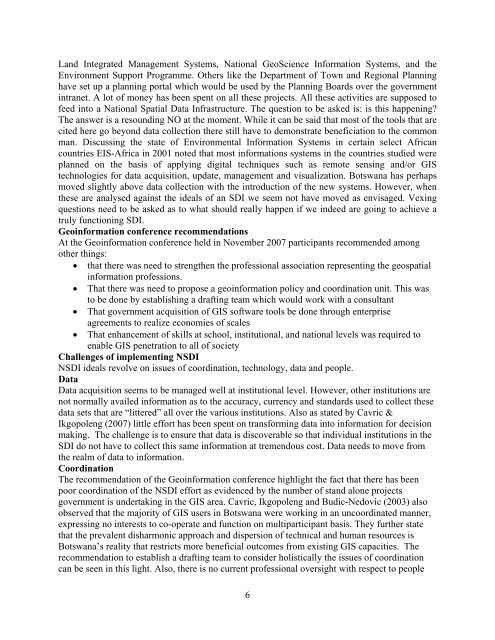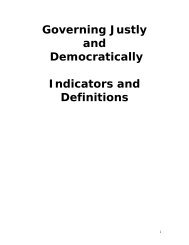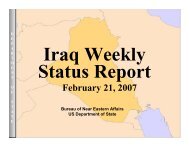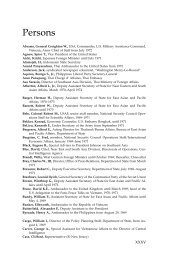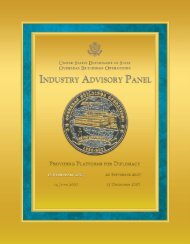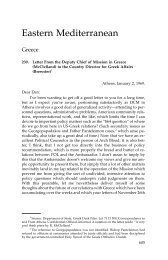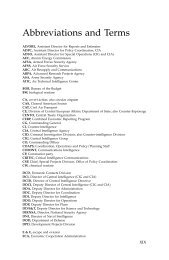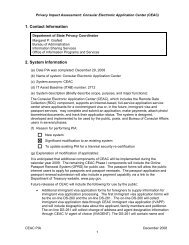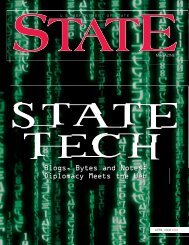Paper - Association of American Geographers
Paper - Association of American Geographers
Paper - Association of American Geographers
You also want an ePaper? Increase the reach of your titles
YUMPU automatically turns print PDFs into web optimized ePapers that Google loves.
Land Integrated Management Systems, National GeoScience Information Systems, and the<br />
Environment Support Programme. Others like the Department <strong>of</strong> Town and Regional Planning<br />
have set up a planning portal which would be used by the Planning Boards over the government<br />
intranet. A lot <strong>of</strong> money has been spent on all these projects. All these activities are supposed to<br />
feed into a National Spatial Data Infrastructure. The question to be asked is: is this happening?<br />
The answer is a resounding NO at the moment. While it can be said that most <strong>of</strong> the tools that are<br />
cited here go beyond data collection there still have to demonstrate beneficiation to the common<br />
man. Discussing the state <strong>of</strong> Environmental Information Systems in certain select African<br />
countries EIS-Africa in 2001 noted that most informations systems in the countries studied were<br />
planned on the basis <strong>of</strong> applying digital techniques such as remote sensing and/or GIS<br />
technologies for data acquisition, update, management and visualization. Botswana has perhaps<br />
moved slightly above data collection with the introduction <strong>of</strong> the new systems. However, when<br />
these are analysed against the ideals <strong>of</strong> an SDI we seem not have moved as envisaged. Vexing<br />
questions need to be asked as to what should really happen if we indeed are going to achieve a<br />
truly functioning SDI.<br />
Geoinformation conference recommendations<br />
At the Geoinformation conference held in November 2007 participants recommended among<br />
other things:<br />
• that there was need to strengthen the pr<strong>of</strong>essional association representing the geospatial<br />
information pr<strong>of</strong>essions.<br />
• That there was need to propose a geoinformation policy and coordination unit. This was<br />
to be done by establishing a drafting team which would work with a consultant<br />
• That government acquisition <strong>of</strong> GIS s<strong>of</strong>tware tools be done through enterprise<br />
agreements to realize economies <strong>of</strong> scales<br />
• That enhancement <strong>of</strong> skills at school, institutional, and national levels was required to<br />
enable GIS penetration to all <strong>of</strong> society<br />
Challenges <strong>of</strong> implementing NSDI<br />
NSDI ideals revolve on issues <strong>of</strong> coordination, technology, data and people.<br />
Data<br />
Data acquisition seems to be managed well at institutional level. However, other institutions are<br />
not normally availed information as to the accuracy, currency and standards used to collect these<br />
data sets that are “littered” all over the various institutions. Also as stated by Cavric &<br />
Ikgopoleng (2007) little effort has been spent on transforming data into information for decision<br />
making. The challenge is to ensure that data is discoverable so that individual institutions in the<br />
SDI do not have to collect this same information at tremendous cost. Data needs to move from<br />
the realm <strong>of</strong> data to information.<br />
Coordination<br />
The recommendation <strong>of</strong> the Geoinformation conference highlight the fact that there has been<br />
poor coordination <strong>of</strong> the NSDI effort as evidenced by the number <strong>of</strong> stand alone projects<br />
government is undertaking in the GIS area. Cavric, Ikgopoleng and Budic-Nedovic (2003) also<br />
observed that the majority <strong>of</strong> GIS users in Botswana were working in an uncoordinated manner,<br />
expressing no interests to co-operate and function on multiparticipant basis. They further state<br />
that the prevalent disharmonic approach and dispersion <strong>of</strong> technical and human resources is<br />
Botswana’s reality that restricts more beneficial outcomes from existing GIS capacities. The<br />
recommendation to establish a drafting team to consider holistically the issues <strong>of</strong> coordination<br />
can be seen in this light. Also, there is no current pr<strong>of</strong>essional oversight with respect to people<br />
6


